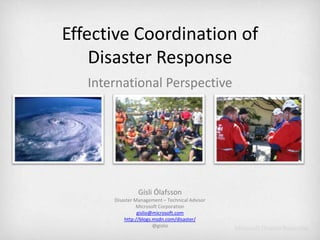
ISCRAM 2010 - Effective Coordination of Disaster Response - International Perspective
- 1. Effective Coordination of Disaster Response International Perspective Gísli Ólafsson Disaster Management – Technical Advisor Microsoft Corporation gislio@microsoft.com http://blogs.msdn.com/disaster/ @gislio
- 5. Connectivity
- 6. Comprehensive Approach Move from Response to Risk Management Risks Full Cycle Constituents
- 7. Coordination Cluster Approach Information Mgmt Crowds Disaster Response
- 8. Coordination
- 9. Coordination in the field
- 10. Cluster Approach
- 12. Information Management on the Ground
- 14. Response HQ New York On-Site Operation & Coordination Center Port-Au-Prince, Haiti Health Cluster Shelter Cluster Distributed Authorship
- 15. Disaster Sites
- 17. The Crowds
- 18. Facilitated Knowledge Management Collaborative Workgroups Social Networks Need for Evolution
- 19. Discussion Boards Comments Podcasting Shared Calendars Microblogging Versioning Profiles Document Libraries Team Sites Tags Blogs Task Lists Wikis Surveys Ratings EnterpriseCollaboration Capabilities SocialComputing Technologies DisasterCommunities The Need for Communities
- 22. People are the problem
- 24. Orgs are the problem
- 26. No relationships – survival
- 27. Only happened a few times (Hiroshima)E=mc2 of disasters
Notas del editor
- AgricultureEmergency TelecomLogisticsWASHCamp Mgmt & CoordinationShelterHealthProtectionEarly RecoveryEducationNutrition
- Thank you!
- But before we do that I want to introduce you to some very interesting research from Professor Denis Mileti, the founder of the Natural Hazard Center in University of Colorado and one of the most leading acadmic researcher in the diaster management space over the last 40 years.When asked what was his most important discovery within the area of disaster mangement, Mileti said that 40 years of his work could be sumarized into this one finding.Mileti said we could define three phases of crisis. The first one is the Routine Emergency phase, something our fire figthers and police officers have to deal with every day. Then there are the disasters which overwhelm the daily responders and cause us to change our behaviour. Finally there are the catastrophees which luckliy only happen very seldom throughout our history.But lets look at these different phases and the behaviour of people during these phases. During the normal routine emergency phase, we look towards organizations such as the police to assist us in the problems we have. And when we interact with these organizations we related to the people we deal with through the roles they represent. In other words, when my house gets on fire, I call the fire department and the firemen will come and help me. I do not refer to them by their names or who they are as persons, in my mind they are representatives of the organization they work for.However during a disaster there is a radical change in our behaviour. The number of organizations involved increases and all of a sudden a coordinated approach is needed. But at this time the organizations become the problem. Political and sometimes financial motives of those organizations hinder them from working efficiently with each other. In the international humanitarian world we often see different UN organizations competing for the attention of the media and the donors instead of collaborating with other organizations involved in the same response. Very often the leadership of those organizations are playing a political game during these periods, something that can realy affect the efficiency of the response. But luckily there is a solution to this problem and in this case it is people. It is people at different levels of the organization which feel human emotions about those affected by the disaster and because of these human emotions are willing to break down and reach out of the organizational silos that they represent. It is through these kind of connection between people within the different organizations that work actually gets done. We must therefore learn to leverage and build up in advance those personal relationships between the people in these organizations.In the third phase, catastrophie, Mileti points out that society breaks down and the basic human instinct of survial kicks in. During this phase relationships no longer matter, only yourself matter. However he points out that lucklily this phase does not last for very long and only happens extreemly seldom.A key point to understand about his findings is that it is not a formal organizational declaration that transititions us between these different phases, but rather it is determined by the behaviour of the people involved.So keep this in mind as I go through the next few slides and discuss methods for effective coordination.
